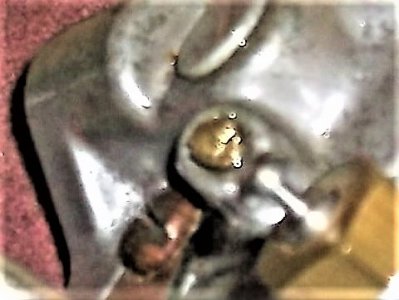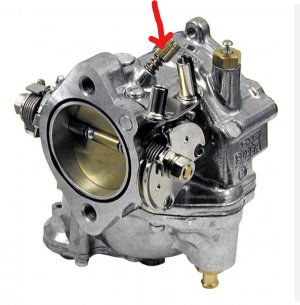-
Welcome back Guest! Did you know you can mentor other members here at H-M? If not, please check out our Relaunch of Hobby Machinist Mentoring Program!
You are using an out of date browser. It may not display this or other websites correctly.
You should upgrade or use an alternative browser.
You should upgrade or use an alternative browser.
I'm stuck...really stuck.
- Thread starter Bone Head
- Start date
- Joined
- Apr 23, 2018
- Messages
- 6,557
You need pics so we can call it more easily from our armchairs. Hopefully the seat isn't ruined. I favor the soldering a copper nut idea if possible. Else, I would have already started drilling. It can't be tight if it's dust in the chip tray.
- Joined
- Jan 25, 2015
- Messages
- 2,558
Not on the idle screw location. Precision sized tapered hole and matching needle. You’re actually getting down pretty close to watchmaking level precision. It’s called a “screw” but its not really a screw. people call it a screw because you adjust idle mixture by turning it in or out. Its actually a tapered needle to meter fuel through a fixed orifice.If all else fails, it might be possible to drill out the screw, tap a slightly larger hole and machine a new screw/valve? Or install a threaded insert and replace with an OEM screw?
You could however, try a reverse twist drill and hope it would grab enough to turn the idle screw out of its bore. Thats a risky move though. Idle screw shaft is usually quite small so hard to drill accurately and if the small bit breaks off in the brass….well, try center drilling a drill bit and you will get the idea…
Last edited:
- Joined
- Feb 26, 2021
- Messages
- 473
Assuming the above is correct, I'd get a package of these from Harbor Freight, and cut a slot in the nub sticking out. If you cut into the carb body a little, don't sweat it. These discs are thin, which is what you want, because the screw is small diameter.
Next, find a screwdriver that's a TIGHT fit. Grind one if you have to. The fit must be tight. Once you get that accomplished, turn the screw both ways; in and out. The idea is to get the screw to move a little. Use your penetrating lube, and heat, as needed. Once you get the screw to move, rock it back and forth; in and out, working towards getting it out of course. DON'T force it, or you will bugger the slot. Back and forth, pent lube, and heat, again and again, until you slowly work the screw out.
I've done this dozens of times before while restoring old carbs. As long as you have a nice tight fitting screwdriver, and a solid slot, the old nub/screw will come out.
Next, find a screwdriver that's a TIGHT fit. Grind one if you have to. The fit must be tight. Once you get that accomplished, turn the screw both ways; in and out. The idea is to get the screw to move a little. Use your penetrating lube, and heat, as needed. Once you get the screw to move, rock it back and forth; in and out, working towards getting it out of course. DON'T force it, or you will bugger the slot. Back and forth, pent lube, and heat, again and again, until you slowly work the screw out.
I've done this dozens of times before while restoring old carbs. As long as you have a nice tight fitting screwdriver, and a solid slot, the old nub/screw will come out.
Attachments
- Joined
- Apr 23, 2018
- Messages
- 6,557
If that's just an air bleed and not a fuel metering screw, even if you bugger it up a bit you can re-cut the seat with a d-bit or hand ground profile drill (even turned by hand like reaming), re-thread the boss and make a new oversized screw. That wouldn't be so bad. The adjustment of an oversize bleed with a different thread pitch may be a little quicker/coarser to tune maybe a bit, but it wouldn't be the end of it. If it's a fuel scew, forget about it, you don't have the wiggle room to lemm out the orifice.
- Joined
- Feb 26, 2021
- Messages
- 473
I wouldn't assume it's an air screw, it may be an air/fuel emulsion metering screw. Worst case, I'd install an insert like this. I've done it a few times with good results.
 20170527_134643 by nessism, on Flickr
20170527_134643 by nessism, on Flickr
 20170527_134643 by nessism, on Flickr
20170527_134643 by nessism, on Flickr- Joined
- Jan 25, 2015
- Messages
- 2,558
Its not a 100% rule, but generally, an idle mixture screw at the front of the venturi is a fuel bleed and behind the venturi is an air bleed. Thats not always true, but its a decent rule of thumb.
Either way, I’d try and get a set of vice grips on it and try walking it in and out until it turns.
I’d probably try filing back the boss a bit to give me more purchase.
Do everything you can to save the body as you can usually order a replacement for that bleed screw.
If you do elect to make a slot, don’t use a NA common screwdriver. They have tapered sides that will try and “cam” itself out of the slot. Get yourself a JIS common screwdriver. JIS has straight sides that help “bite” into the slot.If you have an impact driver, those bits will have striaght sides like a JIS driver.
Also keep in mind that a cut slot is almost always “weak”. If you’re off center even a little bit, you’re just as likely to snap one of the sides off as anything else. Add to that that the stub is pretty small and the chances of snapping off an “ear” of your cut slot is even more likely. Slow, easy and steady are the watchwords here..
Either way, I’d try and get a set of vice grips on it and try walking it in and out until it turns.
I’d probably try filing back the boss a bit to give me more purchase.
Do everything you can to save the body as you can usually order a replacement for that bleed screw.
If you do elect to make a slot, don’t use a NA common screwdriver. They have tapered sides that will try and “cam” itself out of the slot. Get yourself a JIS common screwdriver. JIS has straight sides that help “bite” into the slot.If you have an impact driver, those bits will have striaght sides like a JIS driver.
Also keep in mind that a cut slot is almost always “weak”. If you’re off center even a little bit, you’re just as likely to snap one of the sides off as anything else. Add to that that the stub is pretty small and the chances of snapping off an “ear” of your cut slot is even more likely. Slow, easy and steady are the watchwords here..
Last edited:




